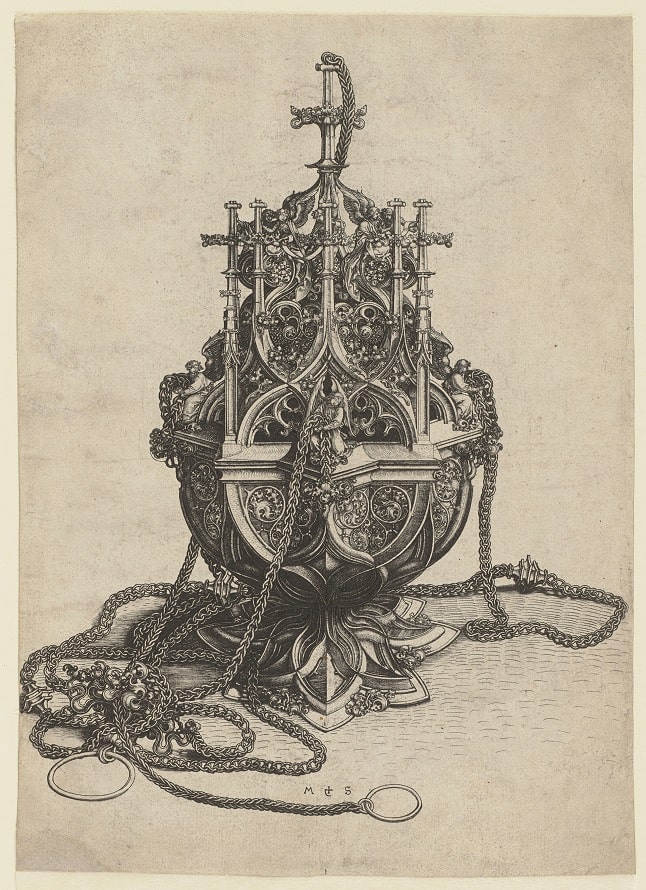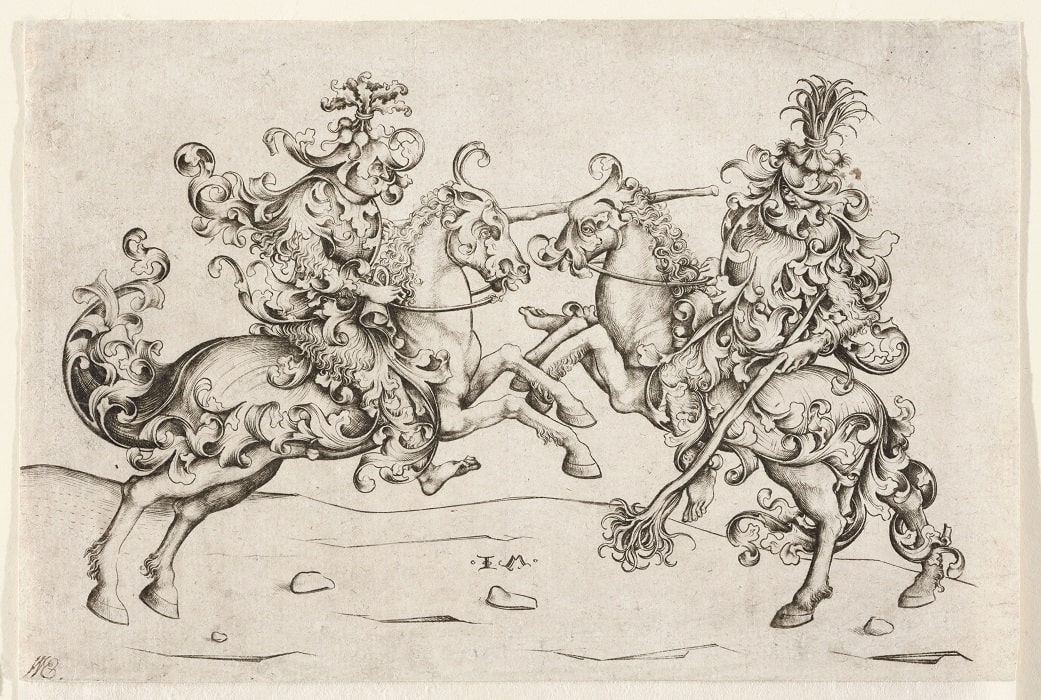The Städel Museum is dedicating its own exhibition to early copperplate engraving as an artistic visual medium. From 28 September 2022 to 22 January 2023, around 130 important German and Dutch copperplate engravings from the 15th century will be presented. The exhibition traces the development of copperplate engraving from simple beginnings to increasingly sophisticated creations.
Image above: Israhel van Meckenem, Fight of Two Wild Men on Horseback, c. 1480
On display are outstanding prints by Martin Schongauer, Wenceslas of Olomouc or Israhel van Meckenem, among others, as well as by early, anonymous engravers such as the Master ES, the Master with the Ribbon Rolls or the Master b(x)g. The exhibition concludes with some of the first engravings by the great German Renaissance artist Albrecht Dürer.
Copperplate engraving is one of the oldest techniques of European image printing. The intaglio printing process developed around 1430/1440 from the art of engraving metal in goldsmiths’ workshops. In the Upper and Lower Rhine regions, and somewhat later in Italy, goldsmiths and painters began to engrave religious and secular depictions on copper plates, which they then printed on paper. The reproduced images were used for private devotion or served as model material for painters, glass painters and sculptors – or other engravers. Gradually, a new world of images spread in print, whose appeal even today lies in a simple yet effective graphic design and an immediate, fascinating narrative joy.
Philipp Demandt, Director of the Städel Museum, on the exhibition: “The exceedingly rare early copperplate engravings not only provide insights into the world of the late Middle Ages. As printed, reproduced and distributed images, they play their own momentous role in art history. Thanks to its first collection inspector Johann David Passavant, the Städel Museum has an outstanding collection. Our exhibition vividly presents how copperplate engraving developed into a new kind of dynamic pictorial medium and how VOR DÜRER. COPPERPLATE ENGRAVING BECOMES ART
“When Dürer founded his workshop in Nuremberg in the last years of the 15th century, he could refer to an already developed tradition. Master ES had created copper engravings in large quantities and established their production as a trade in its own right; with Martin Schongauer, copper engravings had been raised to an artistic level that potentially put them on a par with paintings. The house bookmaster had added an original and spontaneous aesthetic and Israhel van Meckenem had further developed the innovative and economically promising potential of the engraved image. In addition, there were several talented engravers who enriched picture production in the last quarter of the century,” explains Martin Sonnabend, Head of the Prints and Drawings Department until 1750.

The Städel Museum’s early copperplate engravings were for the most part collected around the middle of the 19th century by the then collection inspector Johann David Passavant. Today, the Städel Museum’s holdings comprise around 260 sheets, half of which were acquired by Passavant between 1840 and 1861. Passavant, who was himself a painter and had belonged to the circle of the Nazarenes in Rome in his youth, saw the 15th-century copperplate engravings with the eyes of a Romantic. In the simple, modest, yet Christian and seemingly “for all” images, he could find a kinship with the Nazarene artistic endeavour. This perspective reflected the dual character of the early copperplate engravings as mostly pious “utility pictures” and “works of art” created with creative aspirations. In addition to his collecting activities, Passavant’s merit lies in the extensive recording of copperplate engravings that were little known or not known at all until then. It was the beginning of professional scientific research as the basis of the museum’s work.
The chapters of the exhibition
Early Engravings and the Master ES
The earliest copperplate engravings are distinct rarities today; they were only printed in a few copies anyway. They were created in the workshops of goldsmiths or painters. When engraving the metal plates with the graver, the engravers modelled their motifs with shadow areas of dense stroke bundles, as they occur comparably in pen and ink drawings of the time.
In the beginning, printing was done by placing the paper on the inked plates and then rubbing the image through with a lot of force. The motifs were usually copied from templates.
In addition to the Apostles by the Master of John Baptista (active around 1440-1460? on the Upper Rhine, Basel?) or the Passion copper engravings by the Master with the Ribbon Rolls (active around 1450-1470 in the Eastern Netherlands), the exhibition presents copper engravings by Master ES, including The Little Madonna of Einsiedeln and The Knight and Lady with Helmet and Lance. Master ES was the first “professional” engraver. He was probably trained as a goldsmith and worked around 1440/1450-1467 in the Upper Rhine region, perhaps in Strasbourg. Early on he developed a systematic graphic language whose aim was to rival the quality of painting. The Master ES created up to 500 copper engravings, of which about 300 have survived. There are close references to the Strasbourg painting and sculpture of his time, but also to Franco-Flemish book and panel painting, including the paintings of Rogier van der Weyden that shaped the period.

The early copper engravings were not regarded as valuable works of art and carefully preserved, but were used as pictures. At first, they served mainly religious purposes: for example, figures of saints could be pasted on walls and furniture, touched, worshipped or kissed. Most of the prints by the Master ES were lost through this private use, so the surviving sheets are all the rarer.
Martin Schongauer
In contrast to the engravings by the Master ES, those by Martin Schongauer (Colmar c. 1445-1491 Breisach or Colmar) are mostly preserved in relatively large numbers (about 25 to 80 copies). Schongauer is considered the most important engraver of the 15th century. The son of a goldsmith, he was familiar with metalwork but trained as a painter. Around 1470 he became self-employed and, in addition to his painting, created a body of graphic work comprising just over 100 copper engravings. Schongauer was the first to use a uniform monogram as a signature.
The exhibition includes scenes from the life of the Virgin Mary, the Madonna in the Courtyard and the print Saint Anthony, Tormented by Demons, as well as profane motifs, coats of arms and ornamental works or works related to the art of goldsmithing, such as A Censer. His copperplate engraving compositions were never copies of original pictures, but always his own inventions. He perfected his
graphic language and created technically and artistically highly developed masterpieces. Schongauer understood how to shape the interplay of black line and white paper in copperplate engraving to create a rich painterly effect. In his depictions, light, different material surfaces, space and body volumes come together to form a coherent whole. A special feature of Schongauer’s work are his sensitive studies of nature, observed with the greatest precision. His works were admired and copied throughout Europe, both in copperplate engravings and in paintings and other pictorial media.

German copper engravings 1470-1500
Martin Schongauer’s engravings set standards in the late 15th century. Most engravers of this time were painters or goldsmiths who created prints on the side. Few are known by name, but they marked their works with monograms and house marks, following Schongauer’s example. Master BM (active c. 1480-1500 in southern Germany, Upper Rhine) and Master AG (active c. 1475-1490 on the Upper Rhine and in Franconia, Würzburg) were active in Schongauer’s immediate circle, others, such as Master BR with the anchor (active c. 1480-1490 on the Lower Rhine, possibly in Cologne), knew his engravings and imitated them.
Another influential artist was the so-called “Hausbuchmeister”, who was active in the last third of the 15th century in the Middle Rhine and possibly in a courtly environment. He scratched original and entertaining motifs into soft metal and printed very few impressions. His drypoint etchings became known through copies such as those by the master b(x)g (active around 1470-1490 in the Middle Rhine [Frankfurt am Main?]), by Israhel van Meckenem and also by Wenceslas of Olomouc (active around 1475-around 1500 in Olomouc), a goldsmith from today’s Czech Republic who specialised in re-engravings.
Towards the end of the century, engravers sometimes emphasised the character of their prints as independent works of art. The master LCz (active around 1470-1500 in Franconia) created some sheets that can stand alongside paintings in their pictorial effect, Mair von Landshut (active around 1500 in Freising and Landshut) printed his copper engravings on colour-toned paper and reworked them with the brush into virtuoso chiaroscuro compositions.

Israhel van Meckenem and Dutch Copper Engravings 1470-1500
The most productive and economically successful engraver of the 15th century was Israhel van Meckenem (in or near Bonn c. 1440/1445-1503 Bocholt), a Lower Rhine goldsmith who worked in Bocholt near what is now the Netherlands. Active from about 1470 onwards and highly skilled in engraving technique, he focused on copying patterns that promised a profit. He engraved copper engravings by the master ES, Martin Schongauer and the still young Dürer, but also had specially designed originals supplied by artists such as Hans Holbein the Elder and others. In this way he brought new motifs to the market, especially from the everyday life of his time, which appealed directly to his audience. These include, for example, the morris dances, urban carnival amusements, which appear in his paintings for the first time, and above all the sequence of so-called everyday life.
The Dutch engravers of the later 15th century, who are presented in the exhibition alongside Israhel van Meckenem, were predominantly active along the Lower Rhine, less so in centres of painting such as Bruges or Ghent. They created sophisticated copperplate engravings that technically reveal their knowledge of Martin Schongauer’s works. They show motifs from contemporary Dutch painting, but occasionally also unusual, original depictions.
Albrecht Dürer
Like Martin Schongauer, Albrecht Dürer (1471-1528) was the son of a goldsmith and thus familiar with working metal from childhood. During his training as a painter in his hometown of Nuremberg, he was so impressed by Schongauer’s copperplate engravings that he also visited Colmar during his journeyman’s hike. There, however, he was unable to meet the master, who had died shortly before. When Dürer founded his workshop in Nuremberg around 1495, he only accepted individual commissions for paintings and concentrated primarily on prints. This made him famous throughout Europe within a few years, also thanks to his distinctive monogram. Even his early copper engravings were so successful that they were quickly copied by Israhel van Meckenem, Wenceslas of Olomouc and others. Dürer took the graphic expressive possibilities of copperplate engraving to a new level of quality not achieved by any of his predecessors.

He also used the medium of copperplate engraving for programmatic statements on his self-image as a modern artist, as in Adam and Eve, his masterpiece of 1504. It illustrates how his copperplate engravings, while remaining reproduced, disseminated images, at the same time claimed a novel status as autonomous works of art. Dürer’s Adam and Eve thus forms the final point of the exhibition and at the same time welcomes visitors on the entrance wall – as an invitation to get to know the history and diversity of copperplate engraving “before Dürer”.
WHEN?
Wednesday, 28 September 2022 until Sunday, 22 January 2023
COSTS?
Tickets can be booked online at shop.staedelmuseum.de. Special price up to and including 16 October: 10 euros. The special price is a discounted admission that applies during the redesign of the Modern Art collection area. The special price applies to all visitors, including schoolchildren, students, trainees, job-seekers and visitors with a degree of disability of 50 percent or more. From 18 October: 16 euros, reduced rate 14 euros. Free admission for children under 12.
WHERE?
Städel Museum
Schaumainkai 63
60596 Frankfurt am Main






